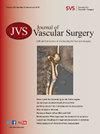颈动脉介入治疗眼部症状后的神经眼科效果。
IF 3.9
2区 医学
Q1 PERIPHERAL VASCULAR DISEASE
引用次数: 0
摘要
导言:根据视网膜缺血的潜在病因,对术前出现视力症状的患者进行颈动脉介入治疗后,神经眼科的长期预后差异很大,目前尚不十分清楚:我们对2018年1月至2022年12月期间出现视网膜缺血并随后接受颈动脉介入治疗的连续患者进行了回顾性回顾。患者被分为三组[I组:Amaurosis fugax(AF)/血管性短暂单眼视力丧失(TMVL),II组:眼部缺血综合征(OIS),III组:视网膜中央/分支动脉闭塞(C/BRAO)]。记录了临床细节和视觉症状的性质。分析结果包括同侧症状复发、视力改善、中风率和存活率:本研究共纳入 90 名患者(70 名男性,75+ 9 岁),其中 31 名患者(34%)属于第一组(房颤),7 名患者(8%)属于第二组(OIS),52 名患者(58%)属于第三组(C/BRAO)。各组的动脉粥样硬化风险因素相似,术前服用抗血小板药物和他汀类药物的情况也相似。64名患者(71%)接受了颈动脉内膜切除术,21名患者(23%)接受了经股动脉颈动脉支架植入术,4名患者(4%)接受了经颈动脉血运重建术,1名患者(1%)接受了颈动脉搭桥术。中位随访时间为 38.5 个月(0-207 个月)。第一组中没有任何患者再次发生一过性或永久性视网膜缺血事件。第二组中出现永久性视力丧失的两名患者的症状没有改善但也没有恶化,第三组中有两名患者出现视力下降。整组患者 5 年的同侧中风率为 2%。1年和5年的存活率分别为93%和82%,组间无差异(P结论:颈动脉内膜切除术和颈动脉支架术后症状复发率都很低,因此对视觉症状进行颈动脉介入治疗后可获得良好的神经眼科效果。如果早期发现(有短暂症状),对 OIS 进行干预可缓解症状并防止永久性视力丧失。本文章由计算机程序翻译,如有差异,请以英文原文为准。
Neuro-ophthalmic outcomes after carotid intervention for ocular symptoms
Background
The long-term neuro-ophthalmic outcomes after carotid intervention in patients presenting with preoperative visual symptoms vary widely based on the underlying etiology of retinal ischemia and are not well understood.
Methods
We performed a retrospective review of consecutive patients presenting with retinal ischemia who subsequently underwent carotid intervention from January 2018 to December 2022. Patients were classified into three groups (group I: amaurosis fugax/vascular transient monocular vision loss, group II: ocular ischemic syndrome [OIS], and group III: central/branch retinal artery occlusion). Clinical details and the nature of visual symptoms were recorded. Outcomes analyzed were ipsilateral symptom recurrence, visual improvement, stroke rate, and survival.
Results
A total of 90 patients were included in this study (70 male, aged 75 ± 9 years): 31 patients (34%) in group I (amaurosis fugax), 7 patients (8%) in group II (OIS), and 52 patients (58%) in group III central/branch retinal artery occlusion. Atherosclerotic risk factors were similar across groups with similar preoperative antiplatelet and statin use. Interventions performed were carotid endarterectomy in 64 (71%), transfemoral carotid artery stenting in 21 (23%), transcarotid artery revascularization in 4 (4%), and carotid artery bypass in 1 patient (1%). The median follow-up was 38.5 months (range: 0-207 months). There was no recurrence of transient or permanent retinal ischemic events in any patient in group I. In group II, 5 of 7 patients presenting with transient symptoms of OIS showed resolution of symptoms and ocular signs. Two patients presenting with permanent vision loss in group II had no improvement but no worsening symptoms, and visual decline was reported in two patients in group III. Ipsilateral stroke rate was 2% at 5 years for the entire group. Survival was 93% and 82% at 1 and 5 years, respectively, with no difference between groups (P < .05). There was one postoperative death from ischemic stroke secondary to stent thrombosis within 30 days (group III), with no long-term mortality from cerebrovascular disease in the rest of the cohort.
Conclusions
Neuro-ophthalmic outcomes after carotid intervention for visual symptoms are favorable with low symptomatic recurrence after both carotid endarterectomy and carotid artery stenting. Intervention for OIS when detected early (with transient symptoms) is associated with resolution of symptoms and prevention of permanent visual loss.
求助全文
通过发布文献求助,成功后即可免费获取论文全文。
去求助
来源期刊
CiteScore
7.70
自引率
18.60%
发文量
1469
审稿时长
54 days
期刊介绍:
Journal of Vascular Surgery ® aims to be the premier international journal of medical, endovascular and surgical care of vascular diseases. It is dedicated to the science and art of vascular surgery and aims to improve the management of patients with vascular diseases by publishing relevant papers that report important medical advances, test new hypotheses, and address current controversies. To acheive this goal, the Journal will publish original clinical and laboratory studies, and reports and papers that comment on the social, economic, ethical, legal, and political factors, which relate to these aims. As the official publication of The Society for Vascular Surgery, the Journal will publish, after peer review, selected papers presented at the annual meeting of this organization and affiliated vascular societies, as well as original articles from members and non-members.

 求助内容:
求助内容: 应助结果提醒方式:
应助结果提醒方式:


